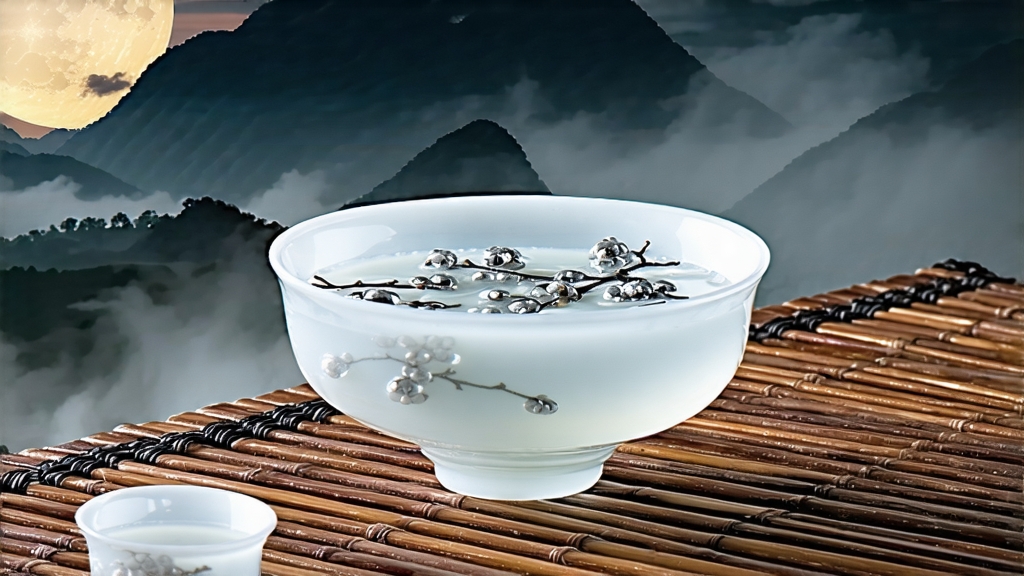
Tucked high on the forested ridges of Yunnan’s Simao and Lincang prefectures, a tea that borrows its name from the moon has quietly seduced growers, poets, and sommeliers for scarcely three decades. Yue Guang Bai—“Moonlight White”—is the youngest celebrity in China’s white-tea family, yet it carries aromas that seem centuries old. To understand it is to step into a nocturnal ritual where chlorophyll sleeps, enzymes dream, and silver leaves glow like polished pewter under starlight.
1. Historical echoes in a young leaf
White tea as a style was first described in the Song dynasty (960-1279), but those early “white” tribute cakes came from Fujian’s now-famous Da Bai cultivars. Yunnan, meanwhile, cultivated broad-leaf Assamica varieties for earthy pu-erh. The marriage of the two worlds happened only in the late 1990s when market demand for gentle, non-fermented teas encouraged Yunnan producers to borrow Fujian’s withering technique. Instead of Da Bai, they used local large-leaf cultivars—trees often 200–800 years old—whose genetic richness gifts Moonlight White its lingering honey-malt depth. Legends soon followed: pickers harvest only on open-moon nights so that “the moon’s yin cools the leaf’s yang,” preventing oxidation. Science dismisses the romance, yet night-picking does keep temperatures low, slowing enzymatic browning and preserving a creamy, lilac note that sun-withered teas rarely achieve.
2. What exactly is Yue Guang Bai?
Chinese white tea is officially graded into Silver Needle, White Peony, Gong Mei, and Shou Mei. Moonlight White sits outside this taxonomy because the leaf morphology is unique: one fat bud plus the first two leaves are plucked, then gently twisted so that the upper surface remains dark jade while the downy underside turns silvery. After drying, the leaf presents a striking yin-yang contrast—hence the “moonlight” moniker. Because the leaf is larger and fleshier than Fujian’s Da Bai, the tea is usually sold as loose “mao cha” rather than pressed cakes, though miniature 100 g moon-cakes for aging experiments are appearing in boutique collections.
3. Crafting by moonlight, or at least by thermometer
Authentic production is limited to a six-week window from late March to early May when overnight mountain temperatures hover between 10 °C and 14 °C and humidity stays above 75 %. After picking, the leaves are spread on ventilated bamboo trays no thicker than 2 cm, then wheeled into dark withering rooms lit only by filtered purple LEDs—just enough lux for workers to see, yet too weak to accelerate photosynthetic oxidation. For 36–48 hours the leaves rest; cell membranes quietly fracture, releasing grassy aldehydes that re-esterify into peach and magnolia lactones. Once the leaf feels leather-tough and emits a faint cocoa perfume, it is transferred to low-temperature ovens set at 35 °C for a final three-hour “soft bake.” Total water loss is gradual—about 60 % in withering, 20 % in baking—preserving long-chain polyphenols that later translate into a thick, glycerine mouthfeel.
4. Flavor lexicon: from bamboo to blackcurrant bud
A well-made 2023 spring batch steeps into a liquor the color of Riesling with a rim of jade fluorescence. First infusions smell of fresh bamboo sap and wet limestone; mid-infusions reveal honeydew, white peach, and a trace of alpine sage. The finish is cool, almost minty, thanks to a high ratio of trans-β-ionone, the same aroma compound found in purple basil. Aged Moonlight White (three years plus) darkens toward amber and trades florals for dried apricot, leather, and a hint of Szechuan pepper. Because Yunnan Assamica contains more caffeine than Fujian Da Bai, the tea delivers a buoyant lift, yet L-theanine levels above 6 mg/g keep the sensation smooth rather than jittery.
5. Brewing: precision without pretense
Western cup method: 3 g leaf, 250 ml 85 °C water, 4 min.